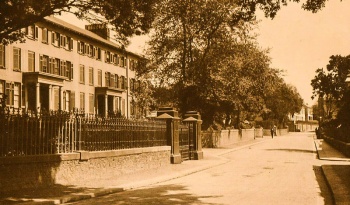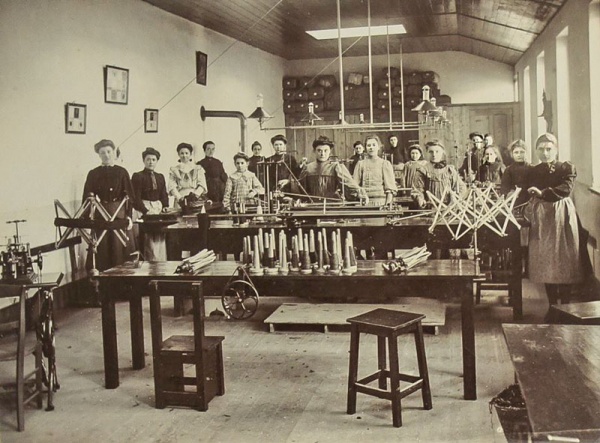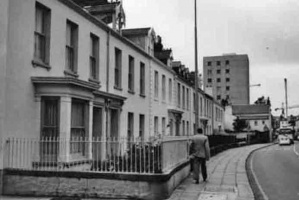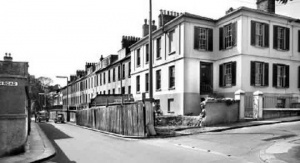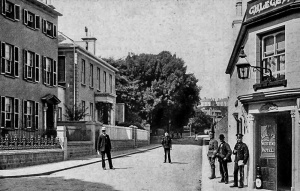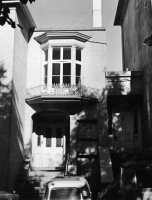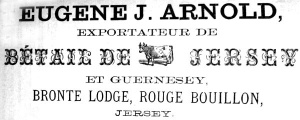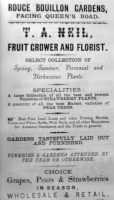As St Helier expanded in the 19th century, the place to live became Rouge Bouillon, which was a very desirable area on the north-west of the town.
Location, Location
Rouge Bouillon is mentioned by name as early as 1570 and is believed to mean ’a bubbling spring tinted by red soil’. This may have derived from the stream running down the valley, prior to the construction of Queen’s Road, which passed through the red clay deposits at Mont à l’Abbé with such force that it was said to boil (bouillier in French).
On maps of St Helier in the 19th century the area is predominantly fields and orchards, with the occasional large residence marked. This changed around the 1830s, when speculators and builders began to transform the area into a very desirable, affluent part of town by building large, expensive residences suitable for more prosperous islanders. Almorah Crescent, Gloster errace, Norfolk Terrace and Victoria Crescent are fine examples of the types of architecture of this period.
Almorah Crescent
Almorah Crescent is of great interest for more reasons than just the splendour of the buildings and the commanding position it held over the town of St Helier [1]. The project was started in 1844 by Charles La Cloche Ricard, son of Edouard Ricard and Jeanne La Cloche, wealthy landowners in this area. The crescent is reported to have been named after the birthplace of Dora Louisa Taylor, the first English child to be born at ‘Almorah’, an ancient town in the foothills of the Himalayas. Dora Louisa Taylor was said to have been the wife of Charles Le Cloche Ricard, however, he was in fact married to Harriet Gladwin and it is believed that Dora was perhaps a business associate.
Charles engaged Francois Le Brun to construct the shell of the properties and in 1845 advertised the incomplete residences for sale. It is difficult to gauge the success of this venture but it was during a period when many speculators and the builders and craftsmen they employed went bankrupt as a result of easy credit.
Charles’ daughter, Dora Louisa Ricard, gives a clue as to the financial success of Almorah in a very bitter letter written to the Evening Post around 1910. She states ‘my father, an imprudent man, lost his fortune in Rouge Bouillon grounds’. It seems he did not lose all of his fortune, however, as there is a letter in the collections of the Jersey Archive dated 1877 from Nice, France in which he agrees to give up his rights to Almorah Road to the town.
Half Pay Officers
As the area gained a reputation as a desirable part of St Helier, through construction projects such as Almorah Crescent, it attracted wealthy and educated residents, not just from Jersey, but from various countries of the world. In the Jersey censuses of 1851 and 1861 many of the inhabitants of Rouge Bouillon and Le Pouquelaye are described as ‘half pay officers’ in the British Army or the Royal Navy.
According to statistics from 1851 the population in Jersey peaked at 57,000, with the bulk of immigrants coming from England and it’s colonies. They were attracted to Jersey by the climate, cost of living and close political affiliations with Britain. It was free from any taxation, imported goods were free of excise and it was relatively close to home for many. Interestingly, many of the immigrants didn’t live in their residences for very long – perhaps they were called back to duty or moved onto new pastures. Between 1851 and 1861 there is only one household out of the 10 at Almorah Crescent whose inhabitants were living in the same house over that period. Every other property had new residents. This must have made for quite a transient community.
Looking at the birthplaces of the residents of this area in the early censuses they are predominantly from England, Ireland, the East Indies and Canada. There are very few Jersey people who are head of the household and anyone with Jersey as their place of birth is generally listed as the cook, servant or nursemaid. Towards the late 19th century more of the successful Jersey businessmen, such as merchants, ship owners, teachers and civil servants took up residence in the area.
Petition to the States
The exclusive nature of the area was threatened when, in 1910, the States of Jersey decided to purchase a piece of land in Rouge Bouillon to build a new town arsenal. This led to an outcry from the residents of the area. A petition was lodged at the States Greffe on 8 November 1910, presented by Deputy John Francis Giffard, and carrying the signatures of 68 residents. In the petition the residents state: ’the district of Rouge Bouillon has always been considered one of the most attractive suburbs of St Helier and all of the houses which have been built there (many of which are of considerable value) have been so built on account of the quietness and seclusion of the neighbourhood and the absence of noise.’
They go on to say: ’the establishment of a Military Arsenal …will be very detrimental to the prosperity of the neighbourhood….would be disastrous…..as it would constitute a permanent source of annoyance to the inhabitants’.
Unfortunately for the residents, Henry Nicolle Godfray, Treasurer of the States, appears to have had a vested interest in the project, as he owned the proposed site and was resident in the neighbourhood himself at a house called Beau Sejour - now the Savoy Hotel. The petition was unsuccessful and the arsenal was built and used until after the Occupation when the building was converted into the Fire Service headquarters. The police station was also built on this site in the 1970s.
Sacré Coeur
The diversification of Rouge Bouillon from a gentile suburb in the 19th century continued with founding of the Sacré Coeur Orphanage in the early 20th century. Father Leon Le Grand, rector of St Thomas, who had came to Jersey in 1899, was very concerned with the social struggle in St Helier for poorer, working parents and saw the need to establish a Catholic run day care for children and fund an orphanage for catholic orphans. He established the Sacré Coeur Orphanage in 1901 in Midvale Road, however it soon became apparent that this site was inadequate and a larger property in Rouge Bouillon, called Summerland House, was purchased. Work began immediately to construct a large building adjoining the house for the orphanage, with the intention that the original house be kept as a convent. Père Le Grand then purchased a property adjacent to the orphanage - St Mary’s House (formerly the Jersey Modern School), on behalf of the parish, to accommodate the older boys.
By December 1904 there were 78 primary age children, 13 babies and nine sisters living at the orphanage. The older boys at St Mary’s House either worked as apprentices in town or in the extensive grounds learning horticultural and gardening skills. For the older girls a textile factory was opened in 1905 in a neighbouring building to provide lessons in housekeeping, sewing and knitting. These skills became a means of employment for the girls when master tailor, Louis Jules Sangan, formed a commercial partnership with the orphanage, creating the ‘Summerland Manufacturing Company’. In 1910 when the factory opened its doors to other girls from the parish it was employing about 60 workers, many of who were not from the orphanage. The history of this successful company is well documented, but they were particularly important during the Occupation for the manufacture of clothing and footwear when there were terrible shortages on the island. Their wooden clogs became known as ‘Summerland Clogs’.
By the 1960’s the need for an orphanage had declined and due to financial difficulties the sisters were forced to sell off part of the properties. St Mary’s House was sold to the States of Jersey in the early 1980s and became the site for the ambulance station and a car park for the police station and houses. The orphanage itself was used as a nursery until it’s closure in 1996 and the subsequent sale of the remainder of the property. Fortunately the chapel and the orphanage building, with its imposing statue of the Sacred Heart, have been maintained in excellent condition by the current owner.
Gallery
Click on any image below to see a full-size version
West End Hotel on the corner with Great Union Road
Businesses
Notes and references
- ↑ Although Almorah Crescent overlooks Rouge Bouillon and most of St Helier, it is some distance to the north on higher ground and it is not clear why it was included in this article

